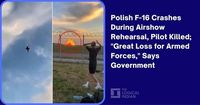Shock and sorrow swept through Poland on August 28, 2025, after a Polish Air Force F-16 fighter jet crashed during a rehearsal for the highly anticipated Radom Air Show, killing the pilot and prompting the immediate cancellation of the weekend event. The incident, which unfolded in central Poland near the city of Radom, has left the nation’s military and aviation communities reeling, while raising fresh questions about the risks inherent in air show performances.
According to multiple reports, including those from Reuters, PAP, and NDTV, the tragedy occurred in the early evening—around 17:30 GMT, or 19:30 CET—during a routine training exercise ahead of the AirSHOW Radom 2025. The jet, an F-16 belonging to the 31st Tactical Air Base near Poznan, was performing a barrel-roll aerobatic maneuver when it suddenly lost control, slammed into the runway, and exploded in a fiery ball. The impact damaged the airstrip, and the aircraft skidded along the tarmac for several meters before coming to a stop.
Government spokesperson Adam Szlapka quickly confirmed the pilot’s death in a social media post, while Deputy Prime Minister and Minister of National Defence Wladyslaw Kosiniak-Kamysz rushed to the scene to assess the situation and offer condolences. In a statement shared on X (formerly Twitter), Kosiniak-Kamysz wrote, “A Polish Army pilot died in the crash of an F-16 aircraft—an officer who always served his country with dedication and great courage. I pay tribute to his memory. I extend my deepest condolences to the family and loved ones. This is a great loss for the Air Force and the entire Polish Army.”
Eyewitness accounts and video footage circulating on social media captured the harrowing final moments of the flight. The F-16 can be seen executing the barrel roll before losing altitude, then plummeting to the runway and erupting into flames. The footage, cited by NDTV and The Logical Indian, shows the jet engulfed in a fireball, with onlookers in shock as rescue crews rushed to the scene.
Authorities were quick to respond. The airport fire brigade, supported by units from the Ministry of the Interior and Administration, initiated rescue operations immediately. Despite their efforts, the pilot was pronounced dead at the scene. Notably, officials from the General Command of the Armed Forces and local emergency services confirmed that no bystanders or spectators were injured—a small mercy amid the devastation.
The Radom Air Show, scheduled for the weekend following the crash, was promptly cancelled. The event, a staple of Poland’s military aviation calendar, typically draws large crowds and showcases the skill and technology of the nation’s air forces. This year’s show was to be no exception, with the F-16 demonstration team expected to be a major highlight. Instead, the airfield became the site of a national tragedy and a somber reminder of the dangers faced by military aviators.
As the investigation into the cause of the crash continues, officials have been careful not to speculate. Both Szlapka and Kosiniak-Kamysz emphasized that the cause remains unknown, with military and aviation authorities launching a full inquiry. The crash has renewed focus on the risks associated with aerobatic displays and the pressures placed on pilots during such high-stakes performances. Training flights and rehearsals for air shows are routine, but as this incident demonstrates, they are not without peril.
Background details provided by PAP and Reuters highlight the experience and dedication of the pilot, whose name has not been released publicly in accordance with military protocol. Kosiniak-Kamysz’s remarks were echoed by colleagues and officials across the Polish defense establishment, who described the fallen officer as someone who “always served his country with dedication and great courage.” The outpouring of grief on social media and from government leaders underscored the pilot’s respected standing within the Air Force and the broader military community.
For the city of Radom, the crash is a particularly bitter blow. The annual air show is not just a military event but a civic celebration, drawing families, aviation enthusiasts, and tourists from across the country and beyond. Its cancellation, while necessary, leaves a void in the city’s cultural calendar and a sense of loss among residents who look forward to the spectacle each year.
Internationally, the incident has drawn attention to the F-16’s role in Poland’s air defense. The F-16 Fighting Falcon, a mainstay of NATO air forces, is renowned for its agility and performance. Poland’s fleet, based at the 31st Tactical Air Base near Poznan, plays a crucial role in both national defense and alliance operations. The crash, while tragic, does not appear to have broader implications for the operational readiness of the Polish Air Force, but it does serve as a stark reminder of the risks faced by those who fly these powerful machines.
In the wake of the accident, tributes have poured in from across Poland’s political spectrum and from military allies. Prime Minister Donald Tusk was briefed on the situation, and Major General Adam Rzeczkowski, among others, was involved in the response. The coordinated efforts of rescue teams, military officials, and government leaders reflected the seriousness with which the tragedy was treated.
As the investigation proceeds, attention will inevitably turn to questions of safety, training, and the future of air shows in Poland. While such events are designed to inspire and celebrate technological achievement, they also place enormous demands on pilots and support crews. The loss of a skilled aviator during what should have been a routine rehearsal is a sobering reminder of the human cost behind the spectacle.
For now, Poland mourns the loss of one of its own—a pilot remembered for his courage, professionalism, and devotion to duty. The echoes of the crash will linger, not only in Radom but across the nation, as the Air Force, the Army, and the public come to terms with a tragedy that unfolded in the pursuit of excellence and national pride.
In the days ahead, as investigators sift through the wreckage and officials reflect on the lessons to be learned, the memory of the fallen pilot will remain at the forefront—a symbol of sacrifice and service in the face of extraordinary risk.



